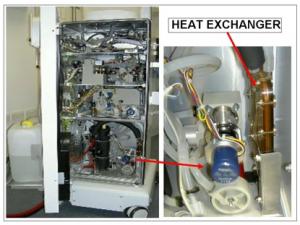- Group home
- You must register/login in order to post into this group.
Retro-fit of Heat Exchangers to Haemodialysis Machines - Case Study and How to Guide

By: East Kent Hospitals University NHS Foundation Trust
£2498.60 (Estimated)
16.46 tonnes CO2e (Estimated)
During haemodialysis, blood is removed from the patient and pumped through a dialyser, before being returned to the patient. Inside the dialyser, waste products in the blood diffuse across a membrane into the ‘dialysate’ fluid, a blend of treated water and chemicals. However, if the dialysate is too cool, the patient may become uncomfortably cold. Cool dialysate also reduces the rate of diffusion, making the treatment less efficient. For these reasons, the dialysate is usually warmed to just below body temperature. The way this warming is done varies. Most machines use a heater controlled by a thermostat to warm the dialysate. However, some machines will also have a heat exchanger incorporated into the system before this heater. In these machines, heat is recaptured from the dialysis effluent (‘used’ dialysate) and transferred to the incoming dialysate, warming it up before it enters the heater and thereby saving energy and reducing the environmental impact of a haemodialysis treatment.
The Kent and Canterbury renal service has predominantly purchased Braun Dialog+ haemodialysis machines, and these have been supplied without heat exchangers. However, the purchase of newer haemodiafiltration machines with built-in heat exchangers highlighted the potential financial and environmental savings that heat exchangers can offer. The renal technicians at the Maidstone dialysis unit decided to investigate the possibility of retro-fitting heat exchangers to their existing machines.
Retro-fit heat exchanger kits for Braun Dialog+ machines can be fitted by most renal technicians in less than half an hour. The technical team selected five machines at random and ran simulated dialysis treatments before and after fitting the machines with heat-exchangers. When they measured the electrical energy used by the machines on each run using a power monitor fitted between the wall socket and the machine plug, they found that the average reduction in power required for each treatment session was 0.86kWh, representing an 18% increase in efficiency (the full results are listed at the end of this case study).
In 2011, funding was obtained for retrofit of 52 machines across the East Kent renal service. The retrofits have now taken place, and energy and cost savings are being monitored.
Environmental Savings (calculations updated October 2012)
Assuming each machine is used twice daily, six days a week for 52 weeks of the year, an annual power saving of 536.64 kWh per machine (2 * 6 * 52 * 0.86) is predicted. Applying a conversion factor of 0.58982 kg CO2 equivalents per kWh*, this in turn equates to an annual saving of 316.5 kg (0.3165 Tonnes) of CO2 equivalents per machine per year. For the 52 machines retrofitted across the Kent and Canterbury renal service, this equates to an annual power saving of 27,905 kWh and an annual carbon saving of 16.46 tonnes of CO2 equivalents.
* GHG emission factor for electricity consumed (2010 grid rolling average) taken from the 2012 Guidelines to Defra / DECC's GHG Conversion Factors for Company Reporting (Table 3c)
Environmental Saving Total Number Conversion
[in tonnes of CO2 = power saving * of * Factor
equivalents] per yr per treatment treatments (0.58982)
(0.86 kWh for run per yr
BBraun Dialog+)
Although the manufacture of heat exchangers incurs a carbon cost in itself, this is estimated to amount to less than one percent of the carbon savings derived from the improved energy efficiency in the first year of use alone.
Investment Appraisal
Given the local electricity rate of £0.089 per kWh, the lower energy usage translates to financial savings of £0.077 per treatment (0.089 * 0.86), and an annual financial saving of £48.05 per machine (if used twice daily, six days a week, for 52 weeks of the year).
Financial saving per treatment = local electricity rate * energy saving per treatment
(£/kWh) (0.86 kWh for Braun Dialog+)
The unit cost of the device (£189) could be recouped within four years (£189/£48.05) and a profit made thereafter. In the case of Kent and Canterbury, following the retrofit of 52 machines with heat exchangers, an annual saving of £2498.60 (£48.05 * 52) is anticipated.
HOW-TO GUIDE: GETTING STARTED
The case study and discussion outlined above includes most of the information required to develop a sound business case for a programme to retro-fit heat exchangers to existing dialysis machines. The following guidance will help you explore the practicalities and assess the financial benefits further.
- Firstly identify whether the machines in your unit are fitted with heat exchangers.
- If not, identify the make of the machine, whether a retro-fit kit exists and what it costs.
- Also, clarify any plans to replace or update the machines.
- Remember that the figure quoted here for the energy saving per treatment (of 0.86 kWh) has been derived from tests using Braun Dialog+ machines. If your unit uses different machines, for which retro-fit heat exchangers are available, you will need to clarify the potential energy saving per treatment (either using the method outlined in this case study, or through correspondence with the manufacturer).
- Ascertain the number of machines to which you plan to fit heat exchangers, and how frequently they are used.
- Find out the local rate for electricity.
- You should now be in a position to follow through the calculations outlined above. This will enable you to determine the potential financial and environmental savings for your unit.
- Funding for projects of this nature is most commonly sought through the budget of the renal service. However, interest free loans for energy efficiency measures may also be available from Salix Finance - http://www.salixfinance.co.uk/home.html
Kent and Canterbury Hospital, Ethelbert Road, Canterbury, Kent, CT1 3NG
Newer haemodiafiltration machines with built in heat exchangers highlighted the potential financial and environmental savings heat exchangers can offer.
